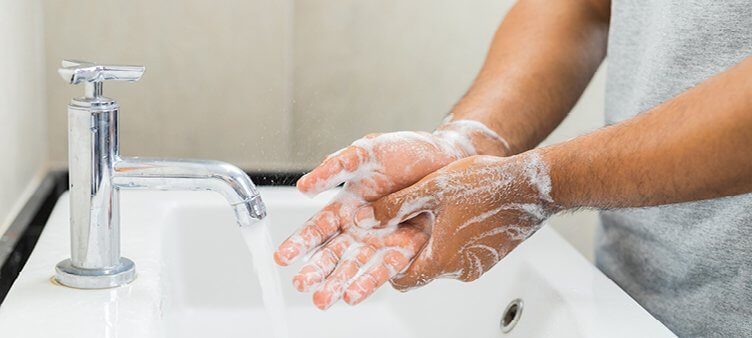
Hygiene has always been critical to survival. From ancient civilisations to our world today, it has played a vital role in preventing the spread of infection and disease. Indeed, in our modern world that’s currently being ravaged by coronavirus, hygiene plays a critical role in health and wellbeing. Unfortunately, however, it’s easy to become complacent and let standards slip.
This is because our way of living is a world away from what it was hundreds of years ago, let alone thousands of years ago. Today, the majority of the world lives somewhat separately or completely from nature, we’ve got the benefit of vaccines against the most dangerous of viruses, diseases, and pathogens, and we’re dependent on antibiotics which has left people in a sort-of comfort zone when it comes to dealing with infections.
This isn’t helped by the fact that these days, diseases and infections that would have once been invariably deadly are nothing than a temporary annoyance and discomfort.
However, the potential dangers of becoming complacent—currently highlighted by the COVID-19 situation but also by the potential for antimicrobial and antibiotic resistance—should serve as a stark reminder that once upon a time, hygiene could have been (and indeed, currently very much be) the difference between life and death. So, perhaps it’s a good idea to pay more attention to hand hygiene after all?
To provide more of a sense of the need for us to all focus on hand hygiene, here are three key moments, according to historians, when hand hygiene played a pivotal role in our world.
Virtually all religions make a connection in their scriptures and religious writings between cleanliness and hand hygiene and spiritual purity.
For many religions, washing in clear water before praying has become a ceremonial part of the prayer process, most notably in Islam where a purification ritual called Wudu requires the washing of faces, hands, arms, and feet. Historically, religious leaders encouraging their followers to wash and bathe is one of the earliest examples of systematic hygiene practices.
In 1546, a physician called Girolamo Fracastoro hypothesised that infections could not only be passed on directly from person to person but also through direct touching and the touching of surfaces with hands. Unfortunately, this is something that was widely ignored for several centuries, as was customary at the time, until the 1800s when germ theory came about.
Germ theory was largely built on Fracastoro’s work and identified microorganisms as the root cause of many diseases. This theory set in motion a total transformation in disease control and led to the creation of modern hygiene practices that prevent the spread of viruses, bacteria, and other pathogens.
It’s all well and good knowing that hand hygiene is important, but without widespread access to handwashing facilities or any other means to clean them then this information is practically useless. Rewind just a couple of hundred years and this is how it was—most people didn’t have easy or widespread access to running water or soap.
The knowledge of how viruses spread and how diseases worked, however, fuelled the development of ways and targeted efforts to stop them from spreading. While soap had been around since as early as 2,800BC—a formula which consisted of water, alkali, and cassia oil—scientists wanted to find new ways to make hand hygiene easier.
Enter synthetic chemistry and the invention of cleansers and hand sanitiser dispenser specifically designed to destroy microbes on the skin, particularly the hands, in 1966. Early hand sanitiser dispenser were primarily used in medical settings until the 1990s when the product was popularised.
Hand sanitiser is made from substances that are known to kill bacteria. This is usually alcohol, but alcohol-free alternatives with different ingredients are available. Alcohol is effective because it has a long history as a disinfectant against many types of viruses and bacteria if the alcohol content is strong enough.
In a hand sanitizer dispenser, alcohol is generally mixed in with water, a gelling agent, and usually fragrance and ingredients to help stop skin drying out. This alcohol attacks the protective outer proteins on viruses and dissolving their membranes. This stops them from functioning, effectively killing them.
The alcohol substance then evaporates from the hand, leaving them dry and sanitised.
Research has shown that hand sanitiser that’s at least 60% per cent alcohol is highly effective against microbes such as 2019-nCoV, the cause of COVID-19. Obviously, the higher the alcohol content then the more effective it’ll be at ridding your hands of pathogens. For reference, hospital hand sanitisers typically have a 95 per cent or higher alcohol content, and you can easily find hand sanitisers as high as 80 per cent alcohol content in shops and online.
Some Nilaqua Hand Sanitiser products alcohol-free hand sanitisers work, too. Nilaqua alcohol-free hand sanitiser kills germs while being kind to skin. When considering an alcohol free hand sanitiser, always check to make sure it’s certified to be effective against pathogens.
While using hand sanitiser can be effective and is better than using nothing at all, the health experts do admit that good old-fashioned soap and water is the best way to practice good hand hygiene and keep yourself (and others) safe.
The important thing to know is that hand sanitiser is a disinfectant. Although it kills germs, it doesn’t physically remove them from the skin like soap and water does. Soap is a detergent, which is why it suds up and dissolves both water and oil, washing them from your hands.
Generally speaking, you should use soap and water instead of hand sanitiser whenever you’re able to access it. However, this isn’t always convenient or entirely feasible, so hand sanitiser is the next best thing. While you could get up to wash your hands every so often while at work, it’s much easier to pop open a bottle of hand sanitiser and rub it into your hands.
There are times when you should opt for soap and water instead of using hand sanitiser, for example if your hands are visibly soiled and dirty or if you’ve been in a potential hotspot area such as on public transport or in a hospital.
Hand Sanitiser Station stocks a range of both alcohol-based and alcohol-free hand sanitisers, plus hand sanitiser dispensers, to both private and commercial customers for use in the home or business.
Visit our online store to find out more or contact a member of the team.
Emir Limam – E11 Group B.V. Netherlands – Fraudster
24 May 2023When to Take a Test After Covid Exposure?
30 January 2023A Rapid Antigen Test vs a Lateral Flow Test for Covid-19
30 January 2023